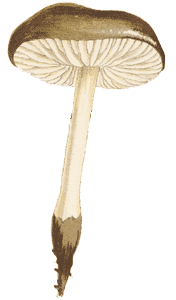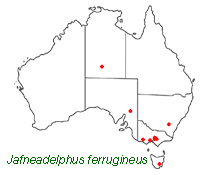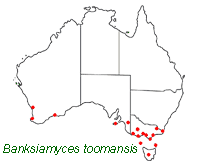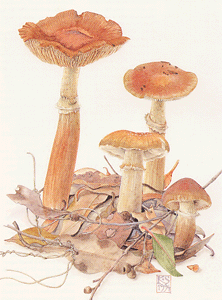 Mycogeography
Mycogeography
Mycogeography within Australia
The bulk of Australian fungal species have not been named and there are large areas of the country that have not been explored from a fungal perspective. What this means is that the comprehensive and accurate species lists, needed for detailed mycogeographical analyses, do not exist. The Fungimap project [FUNGIMAP] aims to fill some of the gaps with the help of non-experts. However, the incomplete data allow some mycogeographical observations and raise some questions.
Bearing in mind the various examples given in the other mycogeography sections, the Australian distributions of some species come as no surprise. So Cyttaria gunnii is found only on Nothofagus trees in eastern Australia, Microporus xanthopus occurs in the wet tropics [Fungimap reference] and Schizophyllum commune is widespread [Fungimap reference]. The Fungimap map of Schizophyllum distribution prompts the question: Is Schizophyllum really absent from the inland areas? Or does the distribution map just reflect the fact that the inland areas are rarely visited by people looking for fungi?
An example of an endemic species with a very wide distribution is Jafneadelphus
ferrugineus ![]() .
.
 |
This distribution map is based on published records and the specimens held at the herbaria in Canberra and Melbourne. While sparse (and undoubtedly under-representing the true distribution of the species) it does at least show that this fungus is found in a wide variety of areas.
Australia's arid areas contain numerous species of fungi and, from earlier comments, it should come as no surprise to learn that Battarraea stevenii, Podaxis pistillaris and Schizostoma laceratum are widespread in Australia's dry inland. There are a number of other puffball relatives and true puffballs which are also restricted to the dry inland - including some endemic species. Australia has many endemic species of truffle-like fungi (see TRUFFLE SECTION), many of them found near the Great Dividing Range and south-west Western Australia. However, there are also at least a couple of desert species - Choiromyces aboriginum and Mycoclelandia bulundari.
It is not surprising to learn that there are fungi found in the Australian tropics that are not found in southern Australia (and vice versa). However, the tropical areas are poorly studied and it is too early to make definitive statements about species endemic to tropical Australia.
 Suillus luteus |
Are there differences between the fungi of the better studied temperate areas of eastern and western Australia? Notwithstanding the possibility of long-distance wind dispersal of spores, the large, dry, central area of Australia forms a formidable barrier to any east-west fungal migration or gene exchange. It is likely that there were widespread species before the creation of that barrier, but it has existed for many millions of years. Therefore any once widespread species will have been split into an eastern and a western population long ago. In some cases the eastern and western populations may have evolved little but in other cases the separate populations may have diverged considerably during those millions of years and evolved into separate species. It is also possible that one population may have become extinct, while the other thrived. While these various hypotheses can be used to explain various east-west similarities or differences, it may be hard to determine which mechanism applies in any particular case.
While there are species restricted to just the east or just the west of Australia,
there are also numerous species found on both sides of the continent. Some species
(such as the bolete Suillus luteus) have been introduced to both areas
while others are naturally found in various parts of the world - they may be
cosmopolitan, Gondwanan relicts and so on. Examples are Schizophyllum commune
![]() ,
Trametes versicolor
,
Trametes versicolor ![]() ,
Fomitopsis lilacinogilva
,
Fomitopsis lilacinogilva ![]() ,
Phlebopus marginatus
,
Phlebopus marginatus ![]() and Podoserpula pusio
and Podoserpula pusio ![]() .
.
 There
are also a number of endemic species found on both sides of the continent. Amongst
the mushrooms, the mycorrhizal Amanita xanthocephala, parasitic Armillaria luteobubalina and carcase-loving Hebeloma aminophilum are examples. Anthracophyllum archeri (virtually a mainland endemic, it's only offshore location being
Lord Howe Island), is a saprotrophic example from both sides Australia. The
genus Banksiamyces is restricted to Australia and the fruiting bodies
grow on Banksia cones. The species Banksiamyces toomansis is found in
both eastern and western Australia, as shown by this distribution map, based
on the specimens held at the Melbourne herbarium.
There
are also a number of endemic species found on both sides of the continent. Amongst
the mushrooms, the mycorrhizal Amanita xanthocephala, parasitic Armillaria luteobubalina and carcase-loving Hebeloma aminophilum are examples. Anthracophyllum archeri (virtually a mainland endemic, it's only offshore location being
Lord Howe Island), is a saprotrophic example from both sides Australia. The
genus Banksiamyces is restricted to Australia and the fruiting bodies
grow on Banksia cones. The species Banksiamyces toomansis is found in
both eastern and western Australia, as shown by this distribution map, based
on the specimens held at the Melbourne herbarium.
The dung-inhabiting Poronia erici is another ascomycete example and amongst the polypores there are Laccocephalum mylittae (previously known as Polyporus mylittae) and Piptoporus australiensis .
There are a few examples of pairs of closely related species, one in eastern
Australia and the other in the west. So, Amanita austroviridis ![]() is green (a rare colour in the fungal world) and found in the south-west of
Western Australia amongst Casuarina. Amanita chlorophylla is green
and found in a few places on the east coast, amongst Casuarina. At present
these "twins" are maintained as separate, but obviously related, species
since there appear to be sufficient points of difference. However, future research
and perhaps discoveries of other green Amanita specimens over a greater
geographical range may show there to be just the one green species in the genus.
The bolete Austroboletus lacunosus of eastern Australia (as well as New
Caledonia and New Zealand) resembles the Western Australian Austroboletus
occidentalis, though the spores are markedly different.
is green (a rare colour in the fungal world) and found in the south-west of
Western Australia amongst Casuarina. Amanita chlorophylla is green
and found in a few places on the east coast, amongst Casuarina. At present
these "twins" are maintained as separate, but obviously related, species
since there appear to be sufficient points of difference. However, future research
and perhaps discoveries of other green Amanita specimens over a greater
geographical range may show there to be just the one green species in the genus.
The bolete Austroboletus lacunosus of eastern Australia (as well as New
Caledonia and New Zealand) resembles the Western Australian Austroboletus
occidentalis, though the spores are markedly different.
Finally there are species found only in the west or only in the east - but
not both - and with no "twin" on the other side of the continent.
From a fungal point of view, Western Australia has been less explored than eastern
Australia. So it is certainly true that species found in eastern Australia may
turn up in Western Australia with a bit more searching. However, some eastern
species are so striking (even to a non-mycologist) that if they were already
established in Western Australia they should have been easily found by now.
Examples of this category are the mushrooms Mycena viscidocruenta ![]() and the stinkhorns Anthurus archeri
and the stinkhorns Anthurus archeri ![]() and Aseroe rubra
and Aseroe rubra ![]() .
.
The bulk of the species found in Western Australia are also found in the east,
with only about 11% restricted to the west - but remember that only about 500
species are currently recorded for WA. The mycorrhizal mushroom genus Amanita
and the truffle-like species contribute most to that 11%. The mycorrhizal mushrooms
Cortinarius phalarus and Rozites symeae are also endemic to WA.
![]() The
Cortinarius is unusual in that there is a volva at the base of the stem
and the fungus resembles some South American species.
The
Cortinarius is unusual in that there is a volva at the base of the stem
and the fungus resembles some South American species.
 Rozites symeae painting by Katie Syme |
Rozites is largely a southern hemisphere genus of mycorrhizal mushrooms.
Fifteen species were known before 1994, only three of them in the northern hemisphere.
Of the twelve southern hemisphere species, 5 were found in New Zealand, 5 in
Argentina/Chile, 1 in New Caledonia and 1 in Papua New Guinea. Apart from the
one PNG species, the other southern hemisphere species were all associated with
Nothofagus, suggesting a Gondwanan origin for Rozites and co-evolution
with Nothofagus. Despite the presence of Nothofagus in Australia,
no Rozites had been (correctly) recorded for Australia until 1994, when
seven species were reported. One of those was already known from New Zealand,
but the other six were new species. Most of the species were found in Nothofagus
or mixed Eucalyptus/Nothofagus forest in Tasmania and Victoria. However,
one species occurred in eucalypt forests in Victoria and Tasmania and another
(Rozites symeae) in wet eucalypt forest in the south-west of Western
Australia. It's not too hard to explain Rozites in the Victorian/Tasmanian
Eucalyptus forests. After all, Nothofagus forests aren't too far
away and it is easy to accept the Rozites in question adapting to eucalypts
millennia ago in a mixed forest. But there is no Nothofagus in Western
Australia. However, a sub-tropical flora, including Nothofagus, was widespread
across southern Australia (into what is now Western Australia) until encroaching
seas in the Miocene created the barren landscape that is now the Nullarbor Plain.
![]() It
is therefore likely that in Western Australia Rozites adapted to partners
other than Nothofagus and so survived the extinction of the western Nothofagus.
It
is therefore likely that in Western Australia Rozites adapted to partners
other than Nothofagus and so survived the extinction of the western Nothofagus.
![An Australian Government Initiative [logo]](/images/austgovt_brown_90px.gif)

